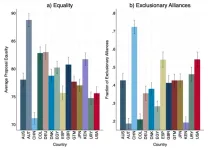Standardizing provider assessments reveals important information about gun and opioid access for veterans at risk of suicide
Study of nearly 39,000 health records is the first to examine access to firearms and opioids, and completion of related interventions, among veterans at risk for suicide receiving care at the VA
2025-01-28
(Press-News.org) PHILADELPHIA—Standardizing an assessment process currently used by doctors during care discussions with veterans at risk for suicide in other context could shed more light on the risks related to firearms and opioids.
The findings from researchers at the Perelman School of Medicine at the University of Pennsylvania were reported today in JAMA Network Open. They found that fewer veterans reported having access to firearms than expected—either because some didn't mention it to their doctor, it wasn't recorded by the provider, or because the true prevalence is lower among this high-risk group.
The research was led by Gabriela Khazanov, PhD, a research associate with the Penn Center for Mental Health and research psychologist with the Corporal Michael J. Crescenz VA Medical Center (VA).
“Veterans have high rates of firearm ownership but may not always share this with their provider as part of suicide safety planning,” Khazanov said. “Some may worry, incorrectly, that their firearms would be confiscated, or their care would be impacted in some way, highlighting the importance of explaining the rationale for these discussions and describing any potential consequences, however unlikely, of firearm disclosure.”
Among veterans, firearm injury accounts for 72 percent of suicides and poisoning, typically by overdose, accounts for 8 percent of suicides among veterans, respectively, with suicides due to opioid overdose nearly tripling over the last 20 years.
The team reviewed health records of 38,454 veterans at risk for suicide receiving suicide safety plans in the VA—a brief, evidence-based intervention that helps patients identify strategies to prevent or de-escalate suicidal crises. One-third of veterans with access to firearms reported storing at least one firearm insecurely and only one-third of veterans with access to opioids accepted naloxone, an overdose-reversing drug. In addition, researchers found that only 5 percent of veterans included reported having access to opioids.
Doctors did report addressing firearm safety with 98 percent of veterans with access to firearms and discussing overdose risks with 79 percent of veterans with access to opioids.
“Veterans may have underreported access to opioids when discussing higher suicide risk due to concerns that their access to prescribed opioids would be limited,” Khazanov said.
Researchers noted that while the study’s relative size was a strength, further study and discussion is necessary on socioeconomic and demographic differences when leading these discussions.
###
Penn Medicine is one of the world’s leading academic medical centers, dedicated to the related missions of medical education, biomedical research, excellence in patient care, and community service. The organization consists of the University of Pennsylvania Health System and Penn’s Raymond and Ruth Perelman School of Medicine, founded in 1765 as the nation’s first medical school.
The Perelman School of Medicine is consistently among the nation's top recipients of funding from the National Institutes of Health, with $550 million awarded in the 2022 fiscal year. Home to a proud history of “firsts” in medicine, Penn Medicine teams have pioneered discoveries and innovations that have shaped modern medicine, including recent breakthroughs such as CAR T cell therapy for cancer and the mRNA technology used in COVID-19 vaccines.
The University of Pennsylvania Health System’s patient care facilities stretch from the Susquehanna River in Pennsylvania to the New Jersey shore. These include the Hospital of the University of Pennsylvania, Penn Presbyterian Medical Center, Chester County Hospital, Lancaster General Health, Penn Medicine Princeton Health, and Pennsylvania Hospital—the nation’s first hospital, founded in 1751. Additional facilities and enterprises include GSPP Rehabilitation, Penn Medicine at Home, Lancaster Behavioral Health Hospital, and Princeton House Behavioral Health, among others.
Penn Medicine is an $11.1 billion enterprise powered by more than 49,000 talented faculty and staff.
END
ELSE PRESS RELEASES FROM THIS DATE:
2025-01-28
Fukuoka, Japan—It goes without saying that the tourism industry in Japan is booming. Walk around any major city and you’ll see people from all around the world enjoying the country’s food, culture, and hospitality. Naturally, the revenue generated by the industry has had a positive economic impact throughout Japan. However, between 2020 and 2022, the tourism industry was hit particularly hard due to the COVID-19 pandemic and subsequent travel restrictions. While the government implemented policies ...
2025-01-28
A new study has taken a closer look at how healthcare quality is measured in three major countries—Israel, the United States, and the United Kingdom—uncovering striking similarities and critical gaps. The research delved into Israel’s Quality Indicators in Community Healthcare (QICH), the US’s Healthcare Effectiveness Data and Information Set (HEDIS), and the UK’s Quality and Outcomes Framework (QOF). While all three systems prioritize family medicine and process-focused metrics, the study highlights a lack of attention to structural and outcome-based ...
2025-01-28
Antarctica, often regarded as the planet’s last true wilderness, harbours unique ecosystems that support extraordinary biodiversity and contribute to global diversity and environmental stability. These ecosystems, which occupy permanently ice-free land covering less than 0.5% of the continent, are now under growing threat from human activity and climate change.
Now, a team led by researchers at UNSW Sydney’s Centre for Ecosystem Science has developed a high-resolution map and hierarchical classification system of Antarctica’s ice-free lands, which can be seen in full in Scientific Data.
This new inventory categorizes Antarctica’s ecosystems ...
2025-01-28
When given the power to distribute resources, a person’s nationality, gender, and ideology can help predict how likely that person is to exclude others to maximize their own profit, according to a study. The results suggest that the identities and cultural backgrounds of decision-makers affect how equitably resources are divided.
Andrzej Baranski and Nicholas Haas placed study participants into groups of three to play a negotiation game. All interactions were via computer and no information about the other ...
2025-01-28
Cold Spring Harbor, NY – Cold Spring Harbor Laboratory Press (CSHL Press) has announced the appointment of new editorial leadership at its renowned journal, Genes & Development. Professor Andrew Dillin has been named Editor-in-Chief, and Dr. Eric Sawey becomes Executive Editor.
These changes are associated with an intentional expansion of the journal’s scope into new and exciting aspects of life science research. While the journal remains committed to its traditional areas of coverage, it will also actively foster additional dynamic fields including physiology, metabolism, aging, gene and environmental interactions, and molecular neuroscience. Genes & ...
2025-01-28
Pancreas cells may produce a protein that can protect the brain from Alzheimer's disease. In individuals with Alzheimer's disease, a peptide known as amyloid-β accumulates and forms tangled plaques. People with diabetes have a higher probability of developing Alzheimer's disease, raising the possibility of a link between the cells that are disordered in diabetes—pancreatic β cells—and the onset of Alzheimer's disease. However, insulin supplementation may not halt the development of Alzheimer's disease. Toru Hosoi and colleagues ...
2025-01-28
PULLMAN, Wash. — An environmentally-friendly preparation of plant material from pine could serve as a substitute for petroleum-based chemicals in polyurethane foams.
The innovation could lead to more environmentally friendly versions of foams used ubiquitously in products such as kitchen sponges, foam cushions, coatings, adhesives, packaging and insulation. The global market for polyurethane totaled more than $75 billion in 2022.
A Washington State University-led research team used an environmentally-friendly preparation of lignin as a substitute for 20% of the fossil fuel-based chemicals in the foam. The bio-based foam ...
2025-01-28
As we burn fossil fuels, the amount of carbon dioxide in Earth’s atmosphere is gradually rising, and with it, the planet’s average temperature. How fast the level of atmospheric carbon dioxide — and with it, the temperature — goes up matters for the ability of humans and ecosystems to adjust. A slower increase gives humans time to move away from low-lying coasts and animals time to move to new habitats.
It turns out the rate of that increase matters for non-living systems, too. A recent University of Washington study looked at how a major current in the Atlantic Ocean that includes the Gulf Stream will respond ...
2025-01-28
The microbial ecosystems within our mouths may affect our cognitive function as we age, according to a study. Interventions such as prebiotics, including dietary nitrate, have potential for delaying cognitive decline.
About 15% of older adults have mild cognitive impairment, which is the largest risk factor for the development of dementia or Alzheimer’s disease. There is a known association between periodontitis—gum disease—and worsened cognitive function. Researchers have identified two possible links between the mouth and the mind: pathogenic ...
2025-01-28
Adopting paywalls subtly shapes newspaper coverage, according to a study. Online journalism is increasingly found behind paywalls, as outlets pivot from funding their operations by selling ads to relying on subscriptions for revenue. This shift has raised questions about how newspapers might adjust their coverage to cater to paid subscribers' desires for popular news and soft news—entertainment, lifestyle, sports, and human-interest stories—at the expense of providing local news and maintaining democratic accountability. Paramveer S. Dhillon ...
LAST 30 PRESS RELEASES:
[Press-News.org] Standardizing provider assessments reveals important information about gun and opioid access for veterans at risk of suicide
Study of nearly 39,000 health records is the first to examine access to firearms and opioids, and completion of related interventions, among veterans at risk for suicide receiving care at the VA





